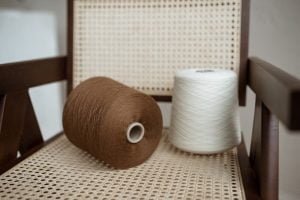If you think that wool clothes are just for cozy fall or winter evenings by the fire with Netflix and snacks, we need to talk. Merino wool is a highly prized natural fiber packed with many beneficial properties surpassing other natural and synthetic materials. It is widely used to make all types of clothing, including underwear, socks, activewear, and outerwear. Let’s look at some of the qualities of this worldwide renowned excellent quality fiber to better understand why it is so popular and valuable.

SUSTAINABILITY
Merino wool is a natural, sustainable, and planet-friendly fiber grown by the breed called Merino sheep, which easily adapts to a wide range of climates and environments. The coat of Merino sheep does not stop growing, and it has to be shorn once or twice a year, depending on the breed. The amount of the wool produced also depends on the breed, and it may range from 4-6lb to 40lb (2-18kg) annually.
BIODEGRADABLE
If there is no way to mend your Merino wool garment and throwing it away for good is the only solution, you can be sure that it will not harm the environment. Unlike synthetic materials, Merino wool needs about a year to be broken down by the microorganisms and bacteria in the ground. Slowly, the soil takes back what it has given away so it could continue feeding us and our environment.
DURABILITY
Merino wool is a durable and strong fiber, but it does not mean that it can be washed or dried in the highest temperature. It has to be taken care of properly, and if you do so, you will enjoy wearing it for a very long time. The natural crimps make the fiber very elastic and usually wrinkle-resistance. Believe it or not, in order for the fiber to break, it has to be bent over 20 000 times, whereas cotton breaks over 3 000 bends, and silk after 2 000 bends. Merino wool is easy to care for, so if you follow the manufacturer’s care recommendations, that Merino wool garment is likely to last forever.
 SOFTNESS
SOFTNESS
Merino wool fibers are measured in microns (μm). A micron is one millionth of a meter, and a single Merino wool fiber is about three times thinner than a human’s hair!
The diameter of the fiber, or the size in microns, determines the softness of the wool, which means that the thinner the fiber, the softer the garment feels. For comparison, a human’s hair measures about 100μm on average, and the finest Merino wool is about 15μm.
Merino wool is highly prized for being the softest wool grown by the sheep, and it is categorized into five main categories: strong, medium, fine, superfine, and ultra fine (also known as extra fine). Monala’s clothes are made of extrafine wool, so even those with sensitive skin can experience the luxurious softness of Merino wool.
ODOR-RESISTANCE
Merino wool is renowned for being capable of fighting off odor-causing bacteria. The wool fiber contains lanolin, a wax produced by the sheep’s glands, which helps to protect the coat from rain. This wax on the fiber does not allow bacteria to thrive but breaks them off. Simultaneously, due to the moisture absorbance property, the fiber keeps the skin dry, preventing bacteria from building up.
Merino wool clothing is a great choice for traveling, so if you are planning a winter holiday trip, consider taking a piece of Merino wool knitwear, which could be aired after your long walks in the oldtown and then worn again the next day. This way you will make more beautiful Instagram pictures in a beautiful outfit and will save space in your luggage.
 HIGH MOISTURE ABSORBANCE
HIGH MOISTURE ABSORBANCE
Merino wool fibers are highly absorbent. They can withhold to 30-35% of their weight in moisture and remain dry to the touch. By absorbing the moisture from the microclimate between the skin and the garment and releasing it to the outer surface, the fibers create the feeling of dryness. It is what makes a garment breathable and comfortable.
TEMPERATURE REGULATION
How does Merino wool know when it is summer, and when winter to keep us cool or warm? It doesn’t. The science behind this property is related to moisture absorbance and air-trapping. The fiber of Merino wool has natural crimps which create air pockets securing the air and insulating the body from the cold. If the body gets sweaty, the fiber absorbs the heat and moisture from the skin and then evaporates it, creating a cooling effect.
 UV RESISTANCE
UV RESISTANCE
It is scientifically proven that Merino wool has an inherent quality of absorbing UV light much better than other natural and synthetic materials such as cotton, silk, acrylic, and nylon. This property, as well as high performance in different conditions, is one of the factors defining why Merino wool is so widely used for base layers and active gear.
FIRE RESISTANT
Most likely, you are not going to sit by the fire wearing Monala’s knitwear, but it is worth mentioning that Merino wool does not melt as quickly as, for instance, nylon. The melting process starts at around 570°C, whereas nylon and polyester start melting at 320-452°C. Be careful with fire!
One thing is clear for sure—there is no universal fiber suitable for everything, and each fiber available in the market has its pros and cons, but knowing the benefits they have does help in choosing the right material matching your values, beliefs, lifestyle, and habits.


